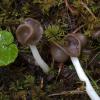
26-09-2011 22:02
 Nicolas VAN VOOREN
Nicolas VAN VOOREN
Bonsoir.Voici une helvelle intéressante, récolt�

26-09-2011 21:33
 Nicolas VAN VOOREN
Nicolas VAN VOOREN
Bonsoir.Trouvé ce samedi ce joli petit disco sur

02-10-2011 12:31
 Yannick Mourgues
Yannick Mourgues
Bonjour à tous.On m'a passé cette pézize trouv�

17-09-2011 23:21
 Yannick Mourgues
Yannick Mourgues
Bonjour à tous.Cet arbre hyper commun en Provence

09-03-2008 10:21
 Karl Keck
Karl Keck
Bonjour, avec une collection de Bertia, morifo

13-05-2010 12:12
Guy ExbrayatSubstrat : Pin Sylvestre ? maladies des bandes ro

18-07-2011 18:55
Hi to all: These resupinate stromata grow on wood

27-09-2011 08:06
Gerard GirodBonjourJe joins ici le programme des 3èmes Journ�
 Bonsoir.
Bonsoir.Voici une helvelle intéressante, récoltée parmi des mousses très humides, dans une tourbière de montagne (alt. 1100 m). Les caractères microscopiques sont compatibles avec H. elastica (cf. PDF), mais macroscopiquement cela me semble différent... Certains spécimens peuvent devenir très luxuriants.
P.-A. Moreau m'a dit qu'il a déjà récolté plusieurs fois ce taxon, toujours dans un milieu similaire.
Quelqu'un a-t-il déjà récolté cette helvelle ?
----
Here is an interesting helvella, collected among wet mosses, in a peat in mountain (alt. 1100 m). Microscopic features are compatible with H. elastica, but macroscopically it seems different... Some specimens could become very luxuriant.
P.-A. Moreau told me that he already collected several times this taxon, always in a similar environment.
Is there anyone who has already gathered such a Helvella species?

Neven

I do not recognize H. latispora in my collection, but I do not reject this hypothesis. The previous collections of H. latispora that I studied were always a bit furfuraceous (with small chains emerging from the ectal excipulum) and the outside colour were white. The ecology is also different.
You can see a good photograph, page 43, in my article published in Bulletin mycologique et botanique Dauphiné-Savoie #199.
It's interesting to note that on the Italian forum Acta Fungorum, Mario Filippa think my collection could be the same fungus that he names H. stevensii.

As I'm not at home at the moment I cannot check some details but as long as I remember I considered H. stevensii to be the syn. of H. latispora. Had a number of transitions between hairy and smooth vestiture on both pileal and/or stipal exc. surface. Also the exc. surface colour may vary considerably (due to quantity and extent of diffuse cell pigment....
But - I will check back later (soon I'll be +/- home and finally out from extra rush for a week or two).
Neven



 Micro
Micro